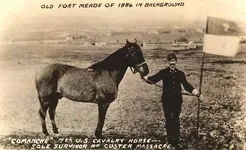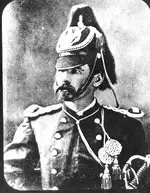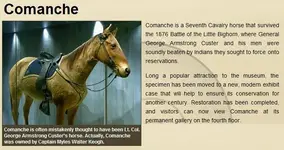X-Terra70_TreasureHunter
Hero Member
- Joined
- Oct 19, 2007
- Messages
- 656
- Reaction score
- 13
- Golden Thread
- 0
- Detector(s) used
- X-Terra70, X-Terra 50, Ace250, Ace150, GTI 1500,GTA 1000 Ultra, Tejon, Vaquero
- #1
Thread Owner


Comanche was a mixed Mustang/Morgan horse who survived General George Armstrong Custer's detachment of the United States 7th Cavalry at the Battle Of The Little Big Horn.
He was bought by the U.S. Army in 1868 in St. Louis, Missouri and sent to Fort Leavenworth, Kansas. Captain Myles Keogh of the 7th Cavalry liked the 15 hand bay gelding and bought him for his own personal mount, to be ridden only in battle. In 1868, while fighting the Comanche in Kansas, the horse was wounded in the hindquarters by an arrow, but continued to let Keogh fight from his back. Thus the horse was named “Comanche” to honor his bravery. Comanche was wounded many more times, always exhibiting the same toughness.
On June 25, 1876, Captain Keogh rode Comanche at the Battle of the Little Bighorn, led by Lt Col. George Armstrong Custer. The battle became famous when their entire detachment was killed. Comanche was found two days after the battle, badly wounded. After being transported to Fort Lincoln, he was slowly nursed back to health.
After a lengthy convalescence, Comanche was retired and orders were given that he should never be ridden again. As an honor, he was made “Second Commanding Officer” of the 7th Cavalry. At Fort Riley, he became something of a pet, occasionally leading parades and indulging in a fondness for beer.
His official keeper, named as Farrier John Rivers of Company I, Keogh's old troop, saved "Comanche's reputation" by answering more fully.
Comanche died in 1890. He is one of only two horses in United States history to be buried with full military honors.
His remains were sent to the University of Kansas and preserved, where they can still be seen today in the university's Natural History Museum.
Comanche is often described as the sole survivor of Custer's detachment, but like so many other legends surrounding the Little Bighorn battle, this one is false.
Comanche was reputed to be the only survivor of the Little Bighorn, but quite a few Seventh Cavalry mounts survived, probably more than one hundred, and there was even a yellow bulldog. Comanche lived on another fifteen years, and when he died, he was stuffed and to this day remains in a glass case at the University of Kansas. So, protected from moths and souvenir hunters by his humidity-controlled glass case, Comanche stands patiently. The other horses are gone, and the mysterious yellow bulldog is gone, which means that in a sense the legend is true.
Comanche alone survived.
His Remains

Sincerely
Dave





 >
> .
.